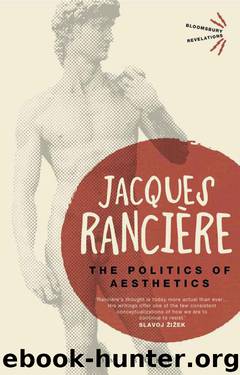The Politics of Aesthetics (Bloomsbury Revelations) by Jacques Rancière

Author:Jacques Rancière [Rancière, Jacques]
Language: eng
Format: epub
Publisher: Bloomsbury Publishing
Published: 2013-05-08T03:00:00+00:00
Politicized art
– Barring a few exceptions, you avoid the concept of commitment. Do you reject this notion because of the false dichotomy it presupposes between art for art’s sake and social reality? Are its inadequacies as a concept due to the fact that it is based on simplistic distinctions between the voluntary and the involuntary, between the individual and society?
– It is an in-between notion that is vacuous as an aesthetic notion and also as a political notion. It can be said that an artist is committed as a person, and possibly that he is committed by his writings, his paintings, his films, which contribute to a certain type of political struggle. An artist can be committed, but what does it mean to say that his art is committed? Commitment is not a category of art. This does not mean that art is apolitical. It means that aesthetics has its own politics, or its own meta-politics. That is what I was saying earlier regarding Flaubert and microscopic equality. There are politics of aesthetics, forms of community laid out by the very regime of identification in which we perceive art (hence pure art as well as committed art). Moreover, a ‘committed’ work of art is always made as a kind of combination between these objective politics that are inscribed in the field of possibility for writing, objective politics that are inscribed as plastic or narrative possibilities.27 The fact that someone writes to serve a cause or that someone discusses workers or the common people instead of aristocrats, what exactly is this going to change regarding the precise conditions for the elaboration and reception of a work of art? Certain means are going to be chosen instead of others according to a principle of adaptation. The problem, however, is that the adaptation of expression to subject matter is a principle of the representative tradition that the aesthetic regime of art has called into question. That means that there is no criterion for establishing a correspondence between aesthetic virtue and political virtue. There are only choices. A progressive or revolutionary painter or novelist in the 1920s and 1930s will generally choose a chaotic form in order to show that the reigning order is just as much a disorder. Like Dos Passos, he will represent a shattered reality: fragmented stories of erratic individual destinies that translate, by their illogicality, the logic of the capitalist order. Painters like Dix or Grosz in Germany, on the other hand, will represent a human/inhuman universe, a universe where human beings drift between marionettes, masks, and skeletons. They thereby play between two types of inhumanity: the inhumanity of the masks and automatons of the social parade and the inhumanity of the deadly machine that upholds this parade. These plastic or narrative devices can be identified with an exemplary political awareness of the contradictions inherent in a social and economic order. They can, however, just as well be denounced as reactionary nihilism or even considered to be pure formal machines without political content.
Download
This site does not store any files on its server. We only index and link to content provided by other sites. Please contact the content providers to delete copyright contents if any and email us, we'll remove relevant links or contents immediately.
| Anthropology | Archaeology |
| Philosophy | Politics & Government |
| Social Sciences | Sociology |
| Women's Studies |
The remains of the day by Kazuo Ishiguro(8393)
Tools of Titans by Timothy Ferriss(7813)
Giovanni's Room by James Baldwin(6808)
The Black Swan by Nassim Nicholas Taleb(6764)
Inner Engineering: A Yogi's Guide to Joy by Sadhguru(6440)
The Way of Zen by Alan W. Watts(6288)
Asking the Right Questions: A Guide to Critical Thinking by M. Neil Browne & Stuart M. Keeley(5356)
The Power of Now: A Guide to Spiritual Enlightenment by Eckhart Tolle(5332)
The Six Wives Of Henry VIII (WOMEN IN HISTORY) by Fraser Antonia(5236)
Astrophysics for People in a Hurry by Neil DeGrasse Tyson(5000)
12 Rules for Life by Jordan B. Peterson(4160)
Housekeeping by Marilynne Robinson(4060)
The Ethical Slut by Janet W. Hardy(4040)
Skin in the Game by Nassim Nicholas Taleb(3965)
Double Down (Diary of a Wimpy Kid Book 11) by Jeff Kinney(3925)
Ikigai by Héctor García & Francesc Miralles(3892)
The Art of Happiness by The Dalai Lama(3846)
Skin in the Game: Hidden Asymmetries in Daily Life by Nassim Nicholas Taleb(3723)
Walking by Henry David Thoreau(3681)
